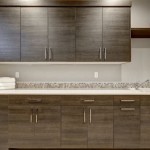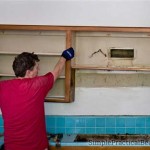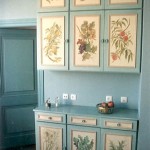DIY Kitchen Cabinet Painting Without Sanding
Painting kitchen cabinets offers a cost-effective way to refresh a kitchen's appearance without the expense of full replacement. Traditionally, this process involved extensive sanding to prepare the surfaces for paint adhesion. However, advancements in paint technology have made it possible to achieve professional-looking results without the laborious sanding step, saving considerable time and effort.
1. Cleaning and Degreasing
Thorough cleaning is the foundation of any successful cabinet painting project, especially when skipping the sanding process. Grease, grime, and cooking residue can prevent paint from adhering properly, leading to peeling and an uneven finish. A strong degreaser specifically designed for kitchen surfaces is recommended. Apply the degreaser following the manufacturer's instructions, ensuring complete coverage of all cabinet surfaces, including corners and crevices. A clean microfiber cloth or sponge should be used to remove the degreaser and any loosened grime. Rinse the cabinets with clean water and allow them to dry completely before proceeding to the next step.
Stubborn grease buildup may require a second application of degreaser or the use of a scrubbing pad. Avoid using abrasive cleaners, as these can scratch the cabinet surfaces. For particularly challenging grease spots, a mixture of baking soda and water can create a gentle yet effective scrubbing paste.
2. Applying Liquid Deglosser
Liquid deglosser, also known as liquid sandpaper, is a chemical agent that etches the surface of the cabinets, creating a rough texture that promotes paint adhesion. This step is crucial for achieving a durable and professional-looking finish without sanding. Apply the liquid deglosser using a clean microfiber cloth or a dedicated applicator pad, working in small sections to ensure even coverage. Follow the manufacturer’s instructions regarding application and drying times.
Proper ventilation is essential when working with liquid deglosser, as the fumes can be strong. Wear gloves and eye protection to prevent skin and eye irritation. Dispose of used cloths and applicator pads according to local regulations.
3. Priming for Optimal Adhesion
Primer serves as an intermediary layer between the existing cabinet finish and the new paint, further enhancing adhesion and ensuring a smooth, uniform final appearance. For cabinets that have not been sanded, a high-quality bonding primer is essential. This specialized primer is formulated to adhere to slick surfaces, providing a secure base for the topcoat. Apply the primer in thin, even coats using a high-quality brush or roller designed for smooth finishes. Allow the primer to dry completely according to the manufacturer's instructions before applying the paint.
Multiple thin coats of primer are generally preferable to a single thick coat. This approach ensures even coverage and minimizes the risk of drips and runs. A light sanding with fine-grit sandpaper between primer coats can further enhance smoothness, but it is not essential when using a high-quality bonding primer.
Choosing the right paint is crucial for achieving a durable and attractive finish. For kitchen cabinets, a high-quality acrylic enamel paint or a cabinet-specific paint is recommended. These paints are formulated to withstand the wear and tear of a busy kitchen environment, offering resistance to moisture, grease, and stains. They are also typically more durable and easier to clean than standard latex paints. Consider the desired sheen level when selecting your paint. Semi-gloss and satin finishes are popular choices for kitchen cabinets as they are durable and easy to clean.
Applying the paint in thin, even coats is vital for a smooth, professional-looking result. Use a high-quality brush or roller designed for smooth finishes, and work in the direction of the wood grain whenever possible. Allow each coat of paint to dry completely before applying the next. Multiple thin coats are preferable to a single thick coat, as this minimizes the risk of drips and runs. For best results, apply at least two coats of paint.
Once the final coat of paint has dried thoroughly, consider adding a protective topcoat for added durability and longevity. A clear polyurethane topcoat can provide an extra layer of protection against scratches, scuffs, and moisture damage, particularly in high-traffic areas like kitchens. Apply the topcoat following the manufacturer’s instructions and allow it to dry completely before using the cabinets.
By following these steps, it's possible to achieve a professional-looking cabinet makeover without the time and effort involved in traditional sanding methods. This process offers a convenient and cost-effective solution for updating the heart of the home.

How To Paint Kitchen Cabinets Without Sanding Sustain My Craft Habit

Painting Over Oak Cabinets Without Sanding Or Priming Hometalk

How To Paint Fake Wood Kitchen Cabinets Simple Made Pretty 2024

How To Paint Kitchen Cabinets Like The Pros

Diy How To Paint Cabinets Without Sanding Vlog

How To Paint Kitchen Cabinets Without Sanding The Budget Decorator

How To Paint Kitchen Cabinets Without Sanding Sustain My Craft Habit

How To Paint Kitchen Cabinets Professionally Without Sanding Diy Makeover Part 1

No Sand Method To Painting Kitchen Cabinets Porch Daydreamer

How To Paint Kitchen Cabinets Without Sanding Or Priming
Related Posts








